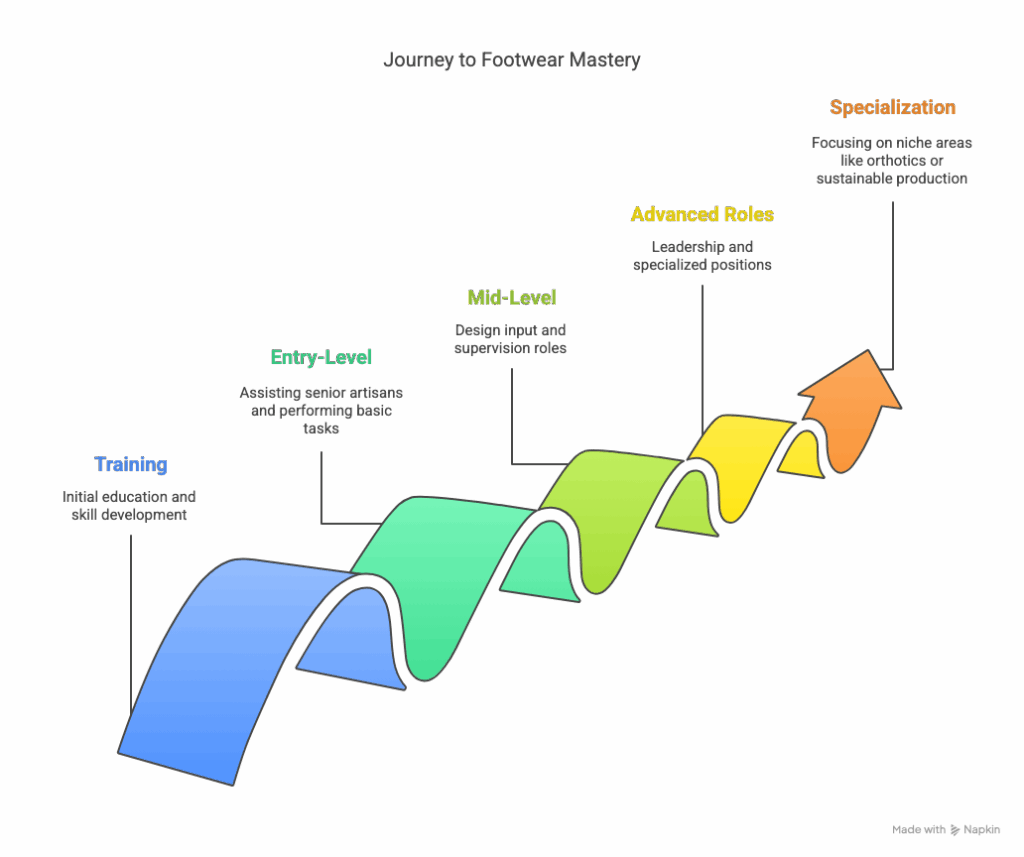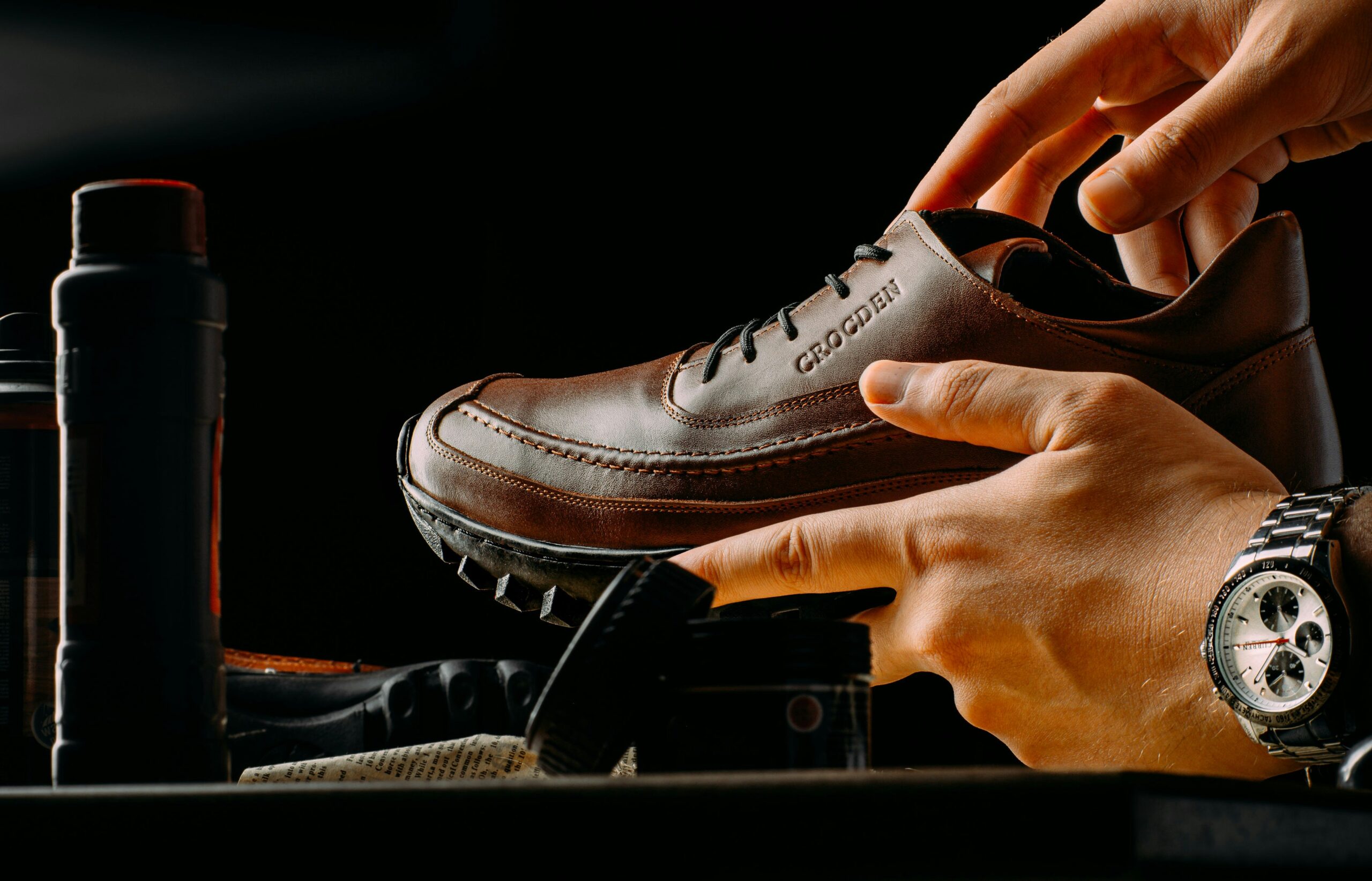Leather workers leverage their skills to create wide-ranging products from wallets to saddles and more. This article however focuses on those who specialise in footwear such as shoes, boots, sandals etc. Read on!
What does a footwear and leather worker do?
Leather and footwear workers are master crafters, they combine their technical precision, time-tested skills with technical precision to create durable, and untional footwear for everyday use or for specialized occasions.
In order to consistently understand better at their work, they must understand material properties, human anatomy, and design principles that support the overall creation of products that are both comfortable and stylish.
From measuring feet and creating patterns to cutting materials and assembling the final product, leather and footwear workers follow a systematic process that dates back to and has evolved over centuries.
Key Skills of leather and footwear workers
Footwear and leather workers generally depend on a specific set of hands on and technical skills, some of which are mentioned below –
Manual dexterity: Cutting, stitching, and assembling leather parts require steady hands.
Pattern interpretation: Reading and working from technical drawings and patterns. It is to ensure product shaping stays accurate and as per demands.
Material knowledge: They must understand the properties of different types of leather and synthetic materials (for example, grain leather, vegan leather etc).
Machinery use: Operating industrial sewing machines, cutting presses, and shaping equipment.
Attention to detail: Every stitch, sole, and seam required detailed and undivided attention. This is more applicable when it comes to working on high-end or custom footwear.
Problem Solving: Making adjustments during production to fix design or material related issues.
Daily Duties of a leather and footwear worker
The type of job, nature of assigned activities, level of complexities involved etc., varies slightly or largely based on where the person works, whether in a large manufacturing setup or a small artisanal workshop. However, generally speaking, their routine tasks include the following:
- Cutting leather or fabric according to templates or digital patterns
- Assembling parts of footwear (uppers, soles, heels etc.,) using stitching or adhesives
- Shaping footwear using molds or lasts
- Operating machines for sewing, pressing, or polishing
- Finishing touches like dyeing, waterproofing, and buffing
- Quality checking for defects in structure or appearance
Career Path of a leather and footwear worker

There are several ways to enter and grow in this profession:
- Training: Many footworkers begin their career through vocational training, apprenticeships, or on-the-job learning.
- Entry-Level: Workers may begin by assisting senior artisans or performing repetitive tasks. Sole attachment is one example in this regard.
- Mid-Level: With experience, they may move into roles requiring design input, prototyping, or supervising assembly lines.
- Advanced Roles: This includes pattern makers, quality controllers or workshop managers. Some transition into footwear design or open their own small labels.
- Specialization: Custom orthotics, fashion footwear, or sustainable shoe production are also growing niches that one may want to pursue as they climb their career ladder.
Leather and footwear worker salary
Compensation for footwear and leather workers can vary significantly based on various deciding factors, such as geography, expertise/skills/experience of the worker, and workplace setting.
Entry-level positions in developing regions may offer lower salaries, while experienced artisans in countries with strong shoemaking traditions, such as Italy and Germany, can earn significantly more.
In the U.S., the average annual wage is approximately $36,850, with top earners getting over $46,000. Specialized artisans working with luxury brands or operating bespoke businesses justifiably command premium prices.
One thing to note here is that this salary range presented is based on publicly available global data. However, wages can vary, as mentioned above, depending on several factors. Economic conditions, experience, employer, and other local factors play a role here too. Readers are encouraged to consult official labor statistics, industry reports and reputed sources for updated and region-specific information.
Footwear worker sample job description
Job Description: Footwear Maker / Leather Footwear Technician
Position Overview
We are seeking a skilled Footwear Maker / Leather Footwear Technician to join our team. In this role, you will be responsible for crafting high quality leather footwear using both traditional techniques and modern equipment. The ideal candidate combines technical expertise with artisanal craftsmanship and attention to detail.
Company Overview
(Add your company details. Focus on elements that may attract the best resources)
Industry
Footwear Manufacturing / Luxury Goods etc.
Location
(Add your location)
Employment Type
(Add employment type)
Responsibilities
- Craft and assemble leather footwear according to design specifications and technical packages
- Operate specialized machinery for cutting, stitching, lasting, and finishing processes
- Select appropriate leathers and materials based on design requirements and quality standards
- Create or modify patterns and templates for production
- Apply various construction methods
- Perform leather preparation techniques such as skiving, splitting, and edge finishing
- Execute detailed hand work including hand-stitching, burnishing, and decorative elements
- Inspect finished products to ensure adherence to quality standards and specifications
- Troubleshoot and resolve construction issues that arise during production
- Collaborate with designers, product developers, or clients on custom pieces
- Maintain tools, equipment, and workstation in optimal condition
- Document production processes and material usage for quality control purposes
- Train and mentor junior staff members when required
- Adhere to all workplace safety protocols and procedures
Required Qualifications
- Minimum 2-3 years of hands-on experience in footwear manufacturing
- Vocational training, apprenticeship, or formal education in leatherwork or shoemaking
- Demonstrated proficiency in footwear construction techniques and leather handling
- Strong understanding of footwear anatomy and ergonomics
- Experience working with various types of leather and identifying quality characteristics
- Proficiency with footwear-specific machinery and hand tools
- Excellent hand-eye coordination and manual dexterity
- Keen eye for detail and commitment to quality craftsmanship
- Ability to read and interpret technical drawings and specifications
- Basic mathematical skills for measurements and pattern scaling
Preferred Qualifications
- Certification from recognized footwear or leather working institution
- Experience with both men’s and women’s footwear styles
- Knowledge of sustainable leather processing and eco-friendly production methods
- Familiarity with CAD software for footwear design
- Experience in a luxury or high-end footwear environment
- Understanding of international quality standards for footwear
- Additional language skills relevant to manufacturing environments
You may also need to add other important factors here, such as salary and benefits, application process, contact details etc. Please note this job description of a leather and footwear worker is for information purposes only. You should modify it by adding, removing information as and where needed.
Sample interview questions for leather and footwear worker jobs
Given below are a few sample questions to judge the technical skills and a candidate’s experience.
Technical & Skill-Based Questions
- Can you walk me through your process for making a pair of leather shoes from start to finish?
- What types of leather and materials are you most comfortable working with?
- Have you worked with industrial machines like clicking presses or skiving machines? Which ones?
- How do you ensure consistency and quality in your work?
- Describe a time when you had to troubleshoot a defect during production. What was the issue and how did you fix it?
Design & Pattern Knowledge
- How do you read and interpret footwear design patterns?
- Have you ever assisted in the design or prototyping of new footwear? Tell us about your role.
- What’s your experience with custom or bespoke footwear projects?
Workplace & Safety
- What safety protocols do you follow when working with heavy machinery and sharp tools?
- How do you maintain your tools and equipment for long-term use?
Experience & Career Motivation
- How long have you been working in leather or footwear production?
- What drew you to this field?
- Do you have experience working in both small-scale artisan workshops and larger production facilities?
- Are you more comfortable with repetitive assembly tasks or creative, customized projects?
Soft Skills & Work Ethic
- How do you handle tight production deadlines or high-volume orders?
- Describe a time you had to collaborate with a design or quality control team.
- What do you think makes a piece of footwear high quality?
Industry Trend
The global leather footwear market size was valued at USD 134.35 billion in 2023 and is expected to grow steadily at a CAGR of 3.1% from 2024 to 2030. (Source).
Footwear craftsmanship, as it always has been, remains very much relevant. Even in the age of automation, this industry is growing at a steady pace.. With a push for sustainable materials and ethical production, skilled footwear workers are finding new opportunities and their demand is only growing.
Leather work is the craft of cutting, shaping, sewing, and finishing leather to make useful or decorative items such as a functional and flexible footwear.
You can find a leather worker through online job platforms, local artisan markets, trade schools, or you can contact workshops that specialize in leather goods.
A person who works with leather is called a leatherworker. These skilled people use tools and techniques to turn raw leather into finished products.
Salary for footwear and leather workers can vary significantly based on various deciding factors. These include geography, expertise/skills/experience of the worker, workplace setting among others.
A leatherworker can also be called a leather artisan, leather crafter, cordwainer (for shoemakers).
Image credit: Unsplash



